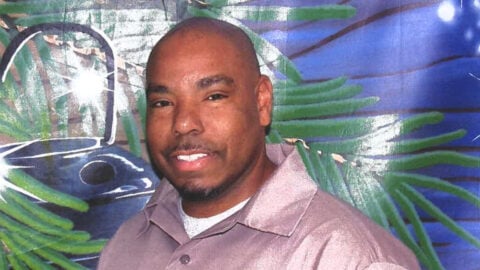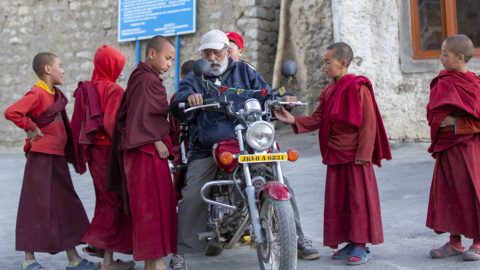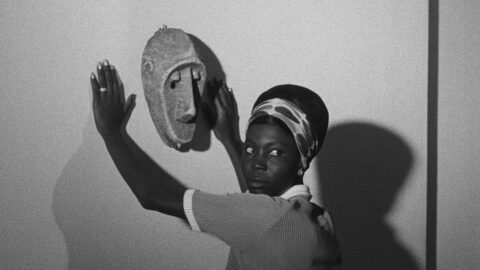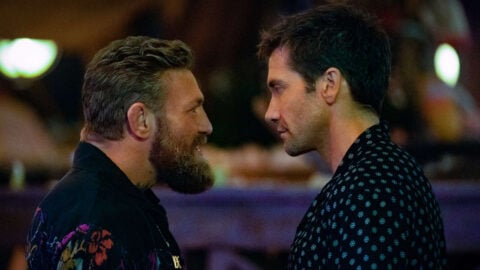Deep Focus: The Gunman

I went into Pierre Morel’s The Gunman with my hopes up, because Sean Penn has done some of his best acting in genre films. In Brian De Palma’s gangster movie Carlito’s Way (93), as a criminal lawyer who turns criminal, Penn is excitingly unpredictable. With circular wire-rims that narrow his eyes and an ugly perm tumbling around his shaved-back hairline, he looks like a soft-boiled egg in a hardboiled world. Emotions don’t just flush this face, they dent it. In Sydney Pollack’s espionage thriller The Interpreter (05), Penn is a soulful Secret Service agent who ends up guarding a U.N. translator (Nicole Kidman) after she eavesdrops on an apparent assassination plot. (It's a marvelous setup: he needs to know everything about her, and she doesn't want to give anything up.) The agent had a troubled marriage that ended when his wife died in a car crash, but Penn doesn't overdo the moroseness; his rue lends fluidity to his just-the-facts-ma'am stance.
In The Gunman, which Penn also co-produced and co-wrote, he plays a character in some ways similar to the Secret Service man in Pollack’s movie. In the main body of the action, he’s a retired mercenary named Jim Terrier. He’s been seeking salvation through good works in the Democratic Republic of the Congo, where (as we see in the introductory sequence) he killed the Minister of Mining in 2006. Suddenly, in his eighth year of atonement, Terrier himself gets targeted for execution. He zigzags from Africa to London to Barcelona, evading or eliminating bad guys at every turn while seeking information from old cronies who’ve risen high in “legitimate” businesses. He also reconnects with his ex-lover, a medical aid worker he abandoned after leaving Africa abruptly, under orders, right after the assassination.
Before long, Jim Terrier is operating on adrenaline and exhaustion. If that combination elevated the hero of The Interpreter into becoming a more open and intuitive man, it reduces the hero of The Gunman to sober efficiency. Penn plays Terrier’s determination so intensely that even the man’s conflicts seem single-minded. Penn may think he’s being genuine and urgent, but the effect is to assure the audience that Terrier is certain to prevail. Nothing could be more discouraging for admirers of Penn’s witty and unruly talent than this unimaginative performance. If hope is “the thing with feathers,” by the end of this film I felt totally plucked.

As a skillful butcher of men, Penn displays a lot of his own beef: he is packing tons of toned muscle as well as firepower. He even gets to surf forbidden African waters, which is meant to establish Terrier as an individualist and a rule-breaker when he’s working for an NGO. I don’t think this is a vanity production, and even if it were, the vanity wouldn’t be what’s wrong. This actor celebrated for relief work in Haiti sees The Gunman as a chance to expose how global players wrest away the resources of mineral-rich, poverty-gutted, politically unstable countries like the Democratic Republic of the Congo.
At a recent press conference, Penn admitted that the film is not a political movie, but he expects young people who see it to respond with greater awareness to news reports about the DRC. He has also said that the film honestly portrays the consequences of violence. But once you commit to the violence that comes with an R rating, how many young, semi-sensitive viewers will line up for it? And how many reports on the chaos and exploitation of the DRC will they ever be exposed to if it doesn’t pop up on Last Week Tonight with John Oliver or The Daily Show?
In Penn’s mind, the film is about a “conflicted man” killing “very bad men” largely for self-serving reasons. To him, that sums up the difference between this film and the same director’s Taken (08), which boasts an inherently romantic actor, Liam Neeson, swinging into action to save his daughter and other defenseless virgins. But underneath its imitation of maturity, The Gunman is just as mechanical as that earlier film and equally reliant on the vengeful emotions behind payback. (For me, Morel’s best movie remains his first, District B-13.)

I was never a Taken fan, but it did re-launch Neeson, in his mid-fifties, as a major action star, and that wasn’t merely because of his imposing height and melodious voice. Playing seasoned men with physical skill sets makes Neeson magnetic; he mixes angst with gallows humor and tough-tenderness, in just the right blend for sane people in an increasingly insane world. Penn conjures no special aura in The Gunman. When it comes to the lunatic game of macho heroics, he’s only a super-respectable contender. Idris Elba, who makes the most of a glorified cameo as an Interpol agent, once told me that one of the great movie challenges was “to play a larger-than-life character vividly and believably. It's a popcorn, have-fun type of thing, but you can't over-act in it, and you can't under-act in it.” Elba negotiates that line with all his righteous masculine presence. Penn gets stuck in neutral.
In the intriguing opening, Penn and his co-writers, Don McPherson and Pete Travis, depict NGO bases as rough-hewn havens within a fractious, bloody milieu. Director Morel cooks up some genial camaraderie among Terrier and his mates, especially a salty Brit named Cox (Mark Rylance) and gradually leads us to understand that they’ve been overseeing the construction of a landing strip. Even then, Morel overplays his hand. Javier Bardem, as Terrier’s friend Felix, looks at Terrier’s lover Annie (Jasmine Trinca) with such undisguised longing—and at Terrier, when he’s with her, with such undiluted jealousy—that his presence undercuts whatever blitheness the resourceful, energetic Trinca draws from Penn. Bardem’s heavy-lidded gaze signals just what’s coming next. I wrote in my reporter’s pad: “It’s David and Bathsheba all over again.” Sure enough, Felix is the liaison between the mercenary group and their mysterious employers—the man who makes Terrier the “designated trigger” for the hit, with orders to exit the continent as soon as his job is done. At least the kill itself is shot and staged with precision as well as impact. My expectations were high when the movie leaped ahead eight years. Indeed, the most effective action scene comes when Penn, having gone straight, gets ambushed and dispatches some scary-looking thugs in brutally efficient combat. (Terrier’s muscle memory is impressive, too.) This sequence’s power comes partly from the way it initiates an innocent Congolese aid worker, Eugene (Ade Oyefeso), into Terrier’s world of carnage. Oyefeso brings so much freshness to his scenes that you want him to stay in the picture.
Terrier and the movie leave him behind as the film devolves into a cat-and-mouse game with several dull cats and one extremely brawny mouse. Ray Winstone does inject some scruffy warmth into the film as Terrier’s London-based comrade Stanley, his one genuine pal. Sadly, I’m not giving anything away. Rylance plays Cox, who now works for the company that ordered the pivotal hit, with such transparent duplicity that you wonder how he ever seals a deal, while Bardem mugs his way through the role of the rapidly deteriorating Felix, who reacts to Terrier’s reappearance as if he knows the jig is up and all is lost. That’s true for the movie, too. With Annie back in step with him and Stanley helping in the background, what’s left for Terrier to do is run the usual gauntlet of physical and emotional traps, shoot-outs and explosions, culminating in a splashy setpiece at a bullfight. When Hitchcock staged a suspenseful climax at a sporting or cultural event, it hinged on some beautiful piece of timing and/or droll bit of business: the cymbal-crash in The Man Who Knew Too Much, Mr. Memory’s need to be true to his act in The 39 Steps, or Robert Walker’s straight-ahead focus on Farley Granger playing tennis while everyone else follows the ball in Strangers on a Train. In The Gunman, Morel merely exploits the physical obstacles of the bullring’s chutes and corridors, and, of course, its bulls.

What’s ironic about The Gunman is that its source novel, by Jean-Patrick Manchette, published in America as The Prone Gunman in 2002, is everything this movie isn’t—stylish, original, uncompromising, suffused with vital black comedy, and political not just on the surface, but at its core. Manchette died young, at 53, in 1995, but he left an indelible mark. He translated American thriller writers like Ross Thomas as well as Alan Moore’s milestone graphic novel, Watchmen. He adapted his own novel, L’Agression, for Claude Chabrol’s too-little-known Nada, a prescient, sardonic attack on terrorism and anti-terrorist excesses. In The Prone Gunman, set almost entirely in France, Manchette’s antihero, Martin Terrier, is an expert in capitalist compartmentalization—a ruthless killer for hire who is also a romantic joke. His one goal has been to earn enough money in a decade to marry a socially superior hometown girl—his “Anne,” not Annie. But she doesn’t wait for him and isn’t really into him, except as a means to escape from bourgeois boredom.
In The Gunman, Jim Terrier is afflicted with a post-concussion syndrome that rarely becomes an issue. In The Prone Gunman, Martin Terrier endures an extended period of muteness—“complete aphonia,” triggered by the shock of seeing Anne in bed with someone else—and ultimately winds up with a bullet lodged in his brain. He’s unable to have intercourse with Anne for more than three minutes at a time, plus one minute for foreplay. As one Gallic psychologist puts it, this length may be extremely brief compared to the behavior “of cultivated and imaginative people . . . But it’s very close to the American national average of the fifties.” The Gunman has been made to satisfy that kind of American. It contains many quick climaxes but few sustained pleasures.







